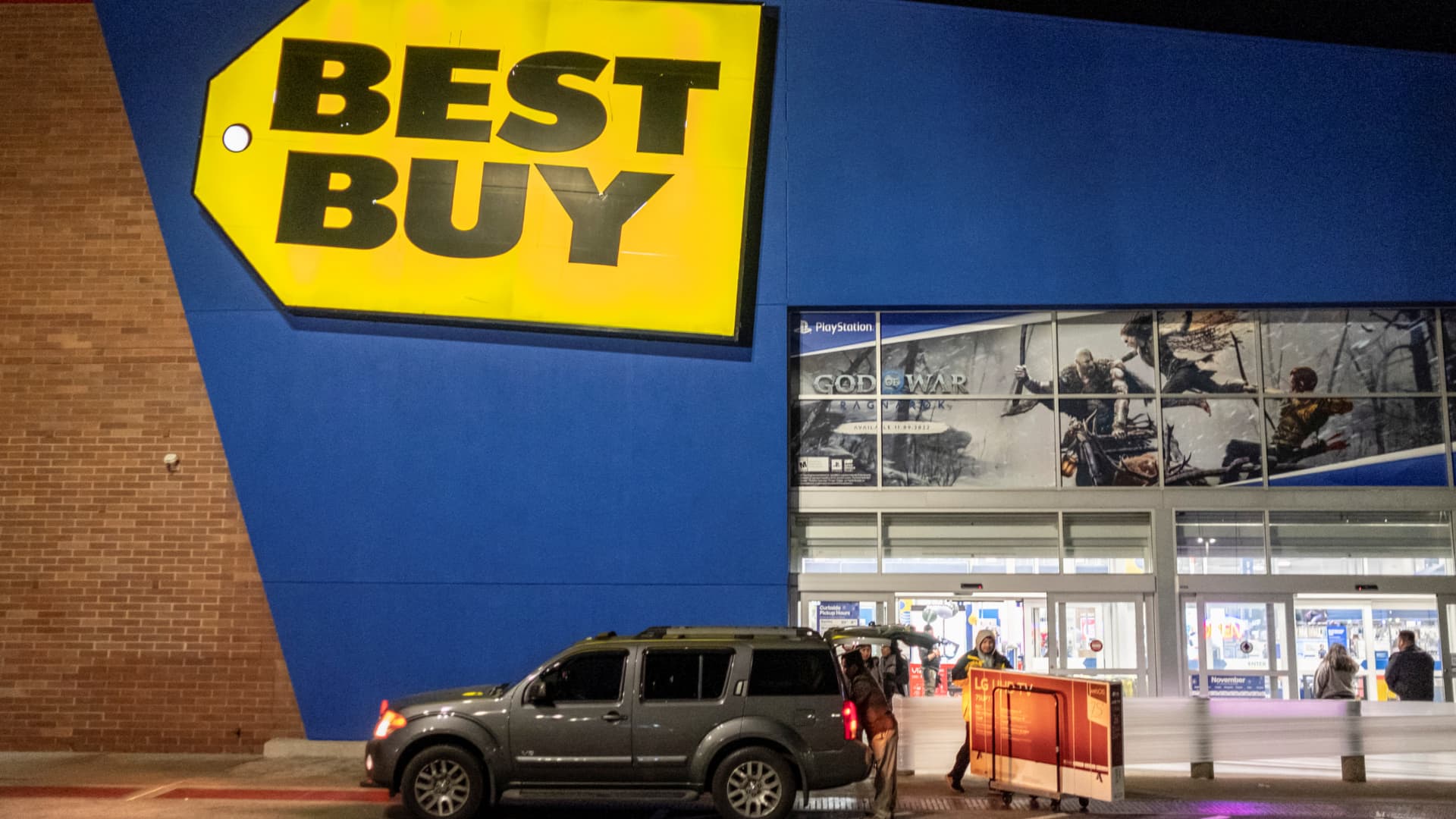Best Buy on Tuesday surpassed Wall Street’s quarterly sales expectations, but tempered its outlook for the rest of the year as it feels the lull of post-pandemic spending on kitchen appliances, computer monitors and other electronics.
CEO Corie Barry said the company still anticipates this year will be “the low point in tech demand,” before sales bounce back.
“Next year the consumer electronics industry should see stabilization and possibly growth driven by the natural upgrade and replacement cycles and the normalization of tech innovation,” she said in a news release.
Here’s how the company did for the fiscal second quarter that ended July 29, compared with what Wall Street was expecting, based on a survey of analysts by Refinitiv:
- Earnings per share: $1.22 adjusted vs. $1.06 expected
- Revenue: $9.58 billion vs. $9.52 billion expected
The company’s stock was up more than 5% in early trading Tuesday to nearly $80 a share.
Best Buy is seeing a reversion to pre-pandemic sales levels, as consumers return to more typical spending patterns and feel pressure on their budgets because of inflation. Similar to Home Depot and Lowe’s, Best Buy had outsized gains during Covid, fueled by big purchases that people don’t frequently repeat.
Over the past year, the consumer electronics retailer has felt the sting of inflation and consumers’ shift back to spending on experiences. It is lapping a year-ago period when it paused share buybacks and cut jobs at stores across the country after slashing its forecast. (The company resumed buybacks late last year.)
In the most recent three-month period, Best Buy’s net income fell to $274 million, or $1.25 per share, from $306 million, or $1.35 per share, a year earlier.
Net sales in the quarter dropped from $10.33 billion in the year-ago period.
Comparable sales, a key metric that includes sales online and at stores open at least 14 months, decreased 6.2% compared with the year ago period as customers bought fewer appliances, home theaters and mobile phones. Gaming systems, on the other hand, were sales drivers in the quarter, the company said.
Online sales in the U.S. tumbled 7.1% year over year, but continued to drive a sizable part of the company’s business. E-commerce accounted for nearly a third of the retailer’s total revenue in the U.S., roughly in line with the year-ago proportion.
The retailer narrowed its full-year outlook. It said it now expects revenue to range from $43.8 billion to $44.5 billion. It had previously anticipated between $43.8 billion to $45.2 billion. For comparable sales, it expects a decline of 4.5% to 6% instead of its prior guidance of between 3% to 6%.
It slightly raised its profit expectations, however. It said it expects adjusted earnings per share of $6 to $6.40 instead of prior guidance of $5.70 to $6.50.
On an earnings call with investors, Chief Financial Officer Matt Bilunas said sales trends are improving, and the company feels optimistic that may continue in the back half of the year. He said back-to-school has been “slightly better than we expected.” And in the second quarter, he said, the volume of laptops and TVs that the company sold was flat instead of declining.
Best Buy has looked to new categories, such as health care, and launched a paid subscription program, My Best Buy, to keep driving growth. Those contributed to a slightly better gross profit rate for its U.S. business in the quarter, as it benefited from those higher-margin businesses.
On the call with investors, Barry said the company is seeing positive traction since relaunching My Best Buy as a three-tier program in late June, including year-over-year growth of paid memberships. The lowest tier of the program is free, but the top tier costs $179.99 per year.
The retailer has reevaluated its store footprint as online sales drive higher costs. On a call with investors, Barry said the company is on track with its brick-and-mortar plans for the fiscal year. The company plans to close 20 to 30 stores, remodel eight stores to turn them into more experiential shops and expand outlet stores from 19 to about 25.
As it gears up for the holidays, Barry said Best Buy expects shoppers will return to “pre-pandemic behavior,” such as “looking for great deals and convenience and traffic will be weighted toward promotional events.”
Shares of Best Buy closed Monday at $74.07, bringing the company’s market value to $16.16 billion. So far this year, the company’s stock is down nearly 8%. That contrasts with the S&P 500’s approximately 15% gains during the same period.

